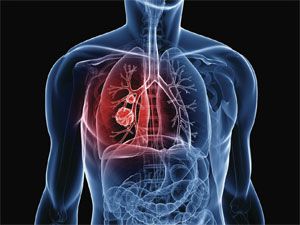FDA Grants Breakthrough Therapy Designation for CO-1686 for EGFR T790M-Positive NSCLC
The EGFR inhibitor CO-1686 has received a breakthrough therapy designation from the FDA for its potential as a treatment for patients with metastatic T790M mutation-positive non-small cell lung cancer (NSCLC) who have received at least one prior line of EGFR-targeted therapy.
NSCLC that is positive for ALK, a receptor tyrosine kinase (RTK), typifies a phenomenon termed “oncogene addiction,†in which tumor cells depend on a single causative pathway or protein for their growth and survival.

The EGFR inhibitor CO-1686 has received a breakthrough therapy designation from the FDA for its potential as a treatment for patients with metastaticT790Mmutation-positive non-small cell lung cancer (NSCLC) who have received at least one prior line of EGFR-targeted therapy.
The new designation was based on results from an ongoing phase I/II study that showed an overall response rate (ORR) of 64% in pretreated patients withEGFR T790Mmutationpositive NSCLC. The FDA's breakthrough therapy designation will help expedite Clovis Oncology's development of CO-1686 for patients with the acquired resistance mutation, which occurs in approximately 60% of patients treated with frontline EGFR inhibitors.
“We very much appreciate this designation by FDA, which recognizes the meaningful benefit CO-1686 may provide patients withT790Mpositive NSCLC,” Patrick J. Mahaffy, president and CEO of Clovis Oncology, said in a release. “This designation is well timed for us as well, as the increased interaction with FDA that it provides will come as we are initiating our registration studies and preparing to submit our initial New Drug Application (NDA) by mid-2015.”
In August 2013, Clovis Oncology transitioned CO-1686 from an initial freebase capsule to the current hydrobromide salt formulation. Following the reformulation, the company noted a lack of cutaneous and gastrointestinal toxicity at the 500 mg daily dose.
Interim results from the phase I/II study that were the basis for the designation were presented at the European Lung Cancer Conference (ELCC) in March 2013. This analysis contained data from 62 patients treated with both formulations of the drug, 22 of which had centrally confirmedT790Mmutations. The median number of prior therapies was 3, including 2 prior EGFR-targeted TKIs.
The ORR of 64% was comprised of all partial responses by RECIST criteria. The clinical benefit rate was 91%. In 29 patients from the study with confirmedT790Mmutations (n = 22) andT790Munknown (n = 7), the ORR was 52%. At 6 months, the median progression-free survival was not reached for patients withT790Mmutations compared with a 3-month median forT790M-negative patients treated with CO-1686.
In total, 1 patient discontinued treatment with CO-1686 as a result of adverse events. The most common all grade adverse events were hyperglycemia, nausea, diarrhea, decreased appetite, and vomiting. The most common grade 3 adverse event was asymptomatic hyperglycemia (19%).
Following the positive results from the phase I portion of the study, two phase II expansion cohorts opened for patients with NSCLC who tested positive for theEGFR T790Mmutation immediately following progression on one or more EGFR-targeted TKI. Additionally, a development program, labeled TIGER (Third-generation Inhibitor of Mutant EGFR in Lung Cancer), is scheduled to start in mid-2014. Clovis expects to submit the NDA for CO-1686 based on findings from the phase I/II study and expected data from part of the TIGER program.
CO-1686 is an oral inhibitor ofEGFRthat selectively binds to activating mutations, includingT790M. The drug is designed to avoid wild-typeEGFRmutations, potentially preventing certain class-specific side effects. Another agent with a similar mechanism of action, AZD9291, was also recently granted a breakthrough therapy designation by the FDA for the treatment ofEGFR T790M-positive patients following progression on a prior EGFR inhibitor.
Data from a phase I study of AZD9291 were presented by the lead investigator, Pasi A. Jänne, MD, PhD, the director of the Lowe Center for Thoracic Oncology at the Dana-Farber Cancer Institute, during a press briefing in advance of the 2014 ASCO Annual Meeting.
This phase I study enrolled 199 patients withEGFR-mutant NSCLC who received treatment with AZD9291 at 5 different doses. In all evaluable patients treated with the drug (n = 177), the ORR was 51%. In patients with confirmedT790Mresistance mutations (n = 89), the ORR was 64% and the disease control rate was 96%. In patients without theT790Mmutation (n = 43), the ORR was 23%.
"In this study, AZD9291 exhibited no dose-limiting toxicities and a non-tolerated or maximum-tolerated dose was not defined," Jänne said during his presentation. "The promising results from this phase I study warrant further investigation of the activity of AZD9291 and additional clinical development is ongoing."









